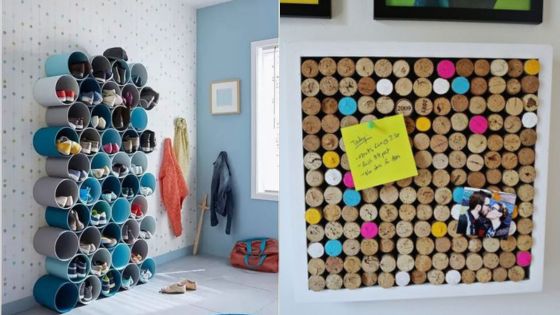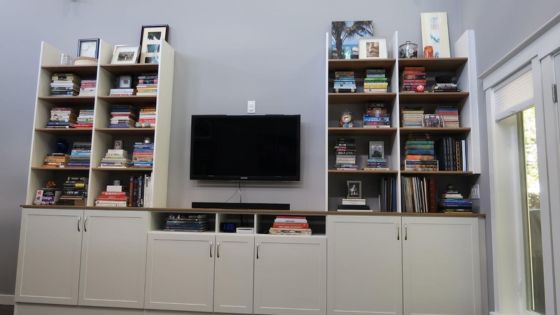Outdoor living spaces have become increasingly popular as people seek to extend their homes and enjoy the fresh air. These areas provide a wonderful opportunity to create comfortable, functional spaces for relaxation, entertainment, and dining.
Whether you have a sprawling backyard or a small balcony, there are numerous ways to transform your outdoor area into a beautiful and inviting space. From cozy seating arrangements to vibrant garden features, the possibilities are endless for enhancing your outdoor living experience.
1) Cozy Fire Pit Corner
A cozy fire pit corner can transform any outdoor space into a warm and inviting area. It provides a perfect spot for gathering with friends and family during cool evenings.
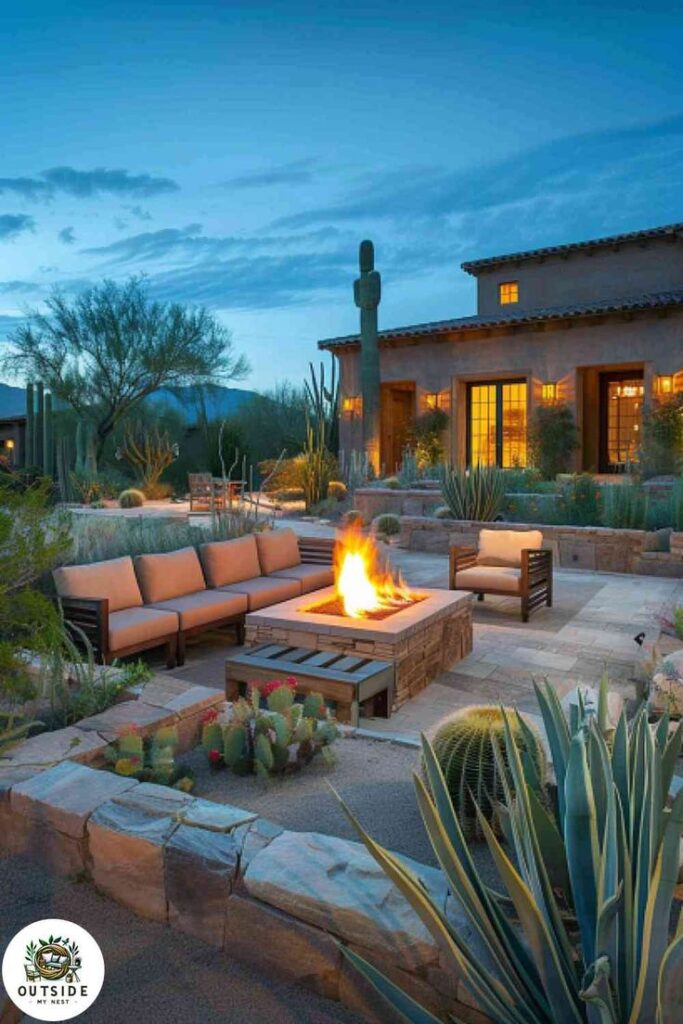
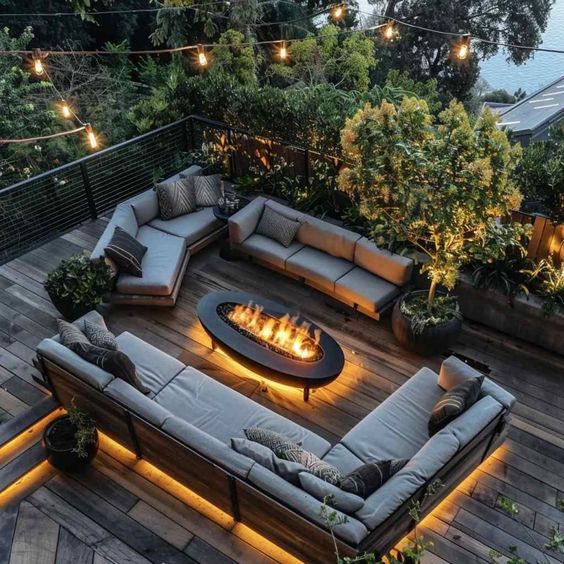
Set up comfortable seating around the fire pit with cushioned chairs or benches. For a more rustic feel, consider using wooden logs or stone seating options.
Adding ambient lighting like string lights or lanterns can enhance the atmosphere. Place the fire pit in a safe area away from trees and overhanging structures.
Consider using pavers or gravel to define the area, making it both functional and visually appealing. Using weather-resistant materials ensures durability against the elements.
Decorate with throw blankets and outdoor pillows for added comfort. This allows guests to stay warm even as the night gets cooler.
Plants and shrubs around the fire pit can add a touch of greenery and a natural feel. Choose low-maintenance plants that thrive in your climate.
A well-designed fire pit corner can become the focal point of your outdoor living space, offering a cozy retreat right in your backyard. For more ideas, you can explore additional options in the Outdoor Entertaining Idea Book.
2) Vertical Herb Garden
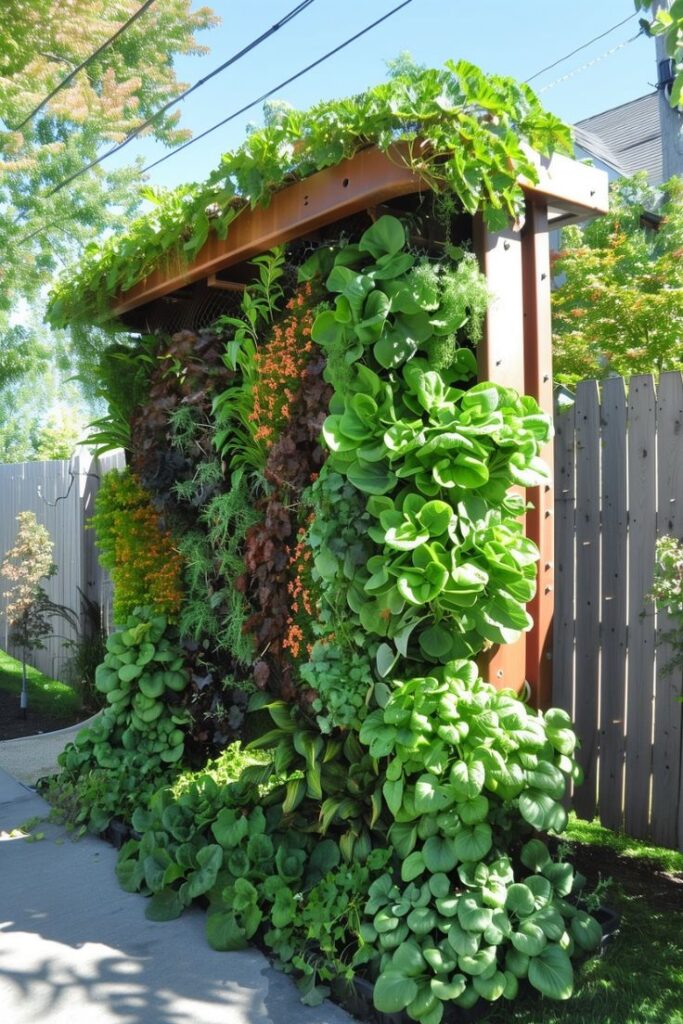
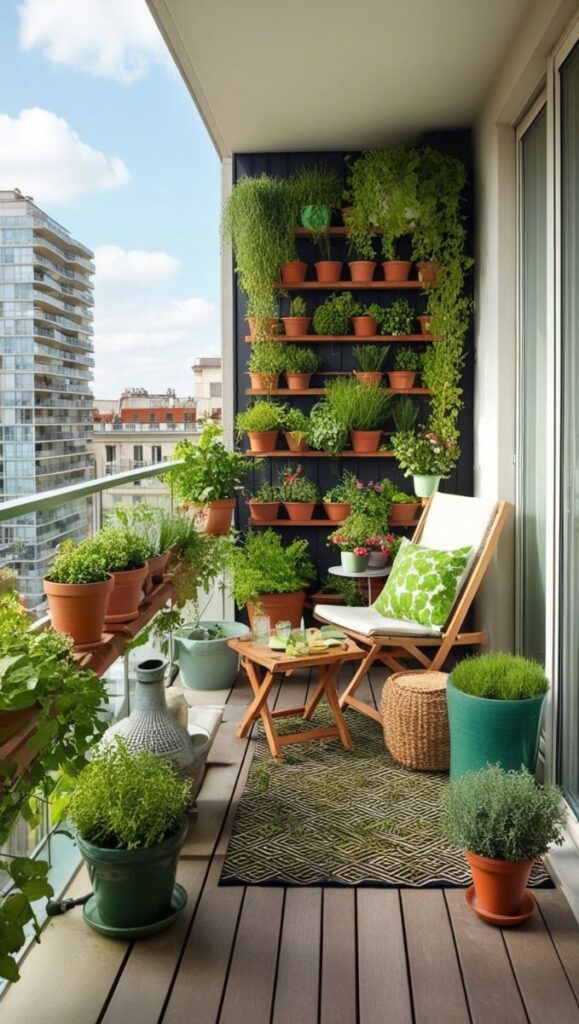
A vertical herb garden is a smart way to use limited space. They can be set up on walls, fences, or even balconies. This makes them perfect for small yards or patios.
The garden’s design keeps herbs easily within reach. This is handy for cooking. Common choices include basil, parsley, and thyme.
Using vertical space can also create a green, lively look. It makes the area feel more inviting. Plus, herbs like mint can deter some pests naturally.
The setup is simple. Hanging planters or shelves work well. Recycled materials like wooden pallets are popular too. Make sure the plants have good drainage.
Regular watering is key. Vertical gardens can dry out faster than ground-level ones. Picking the right spot with enough sunlight is also important. Most herbs need at least 6 hours of sunlight a day.
Involving kids in planting and caring for the herb garden can be a fun activity. This helps educate them about plants and food. Plus, fresh herbs can brighten up meals, enhancing flavor and nutrition.
3) Outdoor Movie Theater
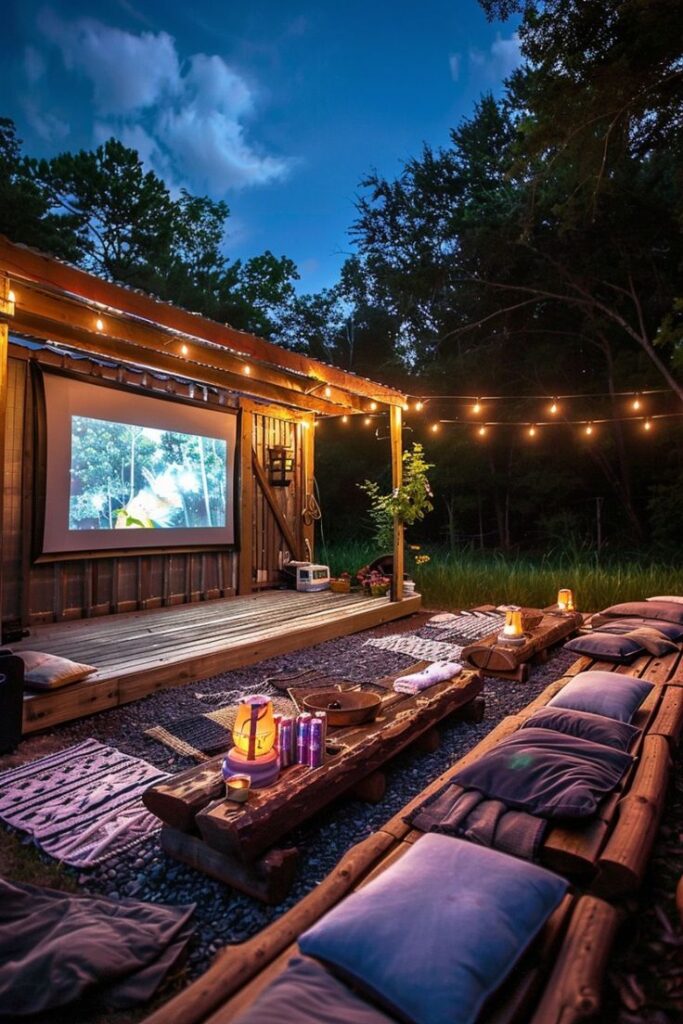
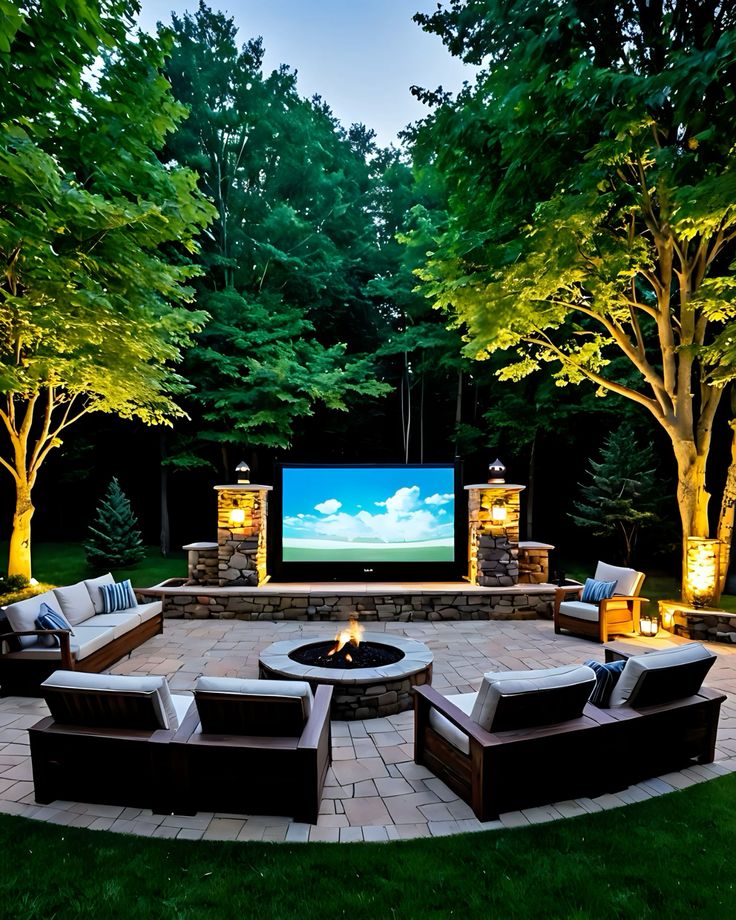
Creating an outdoor movie theater can transform a backyard into an entertainment hub. Start with a large, blank wall or invest in an outdoor projector screen. Choose a projector suitable for outdoor use to ensure clear images.
Comfort is key. Arrange cozy seating options like lounge chairs, bean bags, or even a decked-out patio sofa. Add blankets and pillows for a more inviting ambiance.
Consider using string lights for a magical atmosphere. They provide both decoration and necessary illumination. Surrounding the area with plants or garden features can enhance the experience, making it feel like a natural extension of the home.
For audio, portable outdoor speakers are a practical choice. Choose weather-resistant models to ensure durability. Lastly, don’t forget a small snack station with popcorn, drinks, and candy. This adds convenience and completes the outdoor cinema experience.
Learn more about the appeal and historical significance of outdoor cinemas at Outdoor Cinema. By combining these elements, anyone can create a perfect outdoor movie theater that friends and family will love.
4) Pergola with Climbing Vines
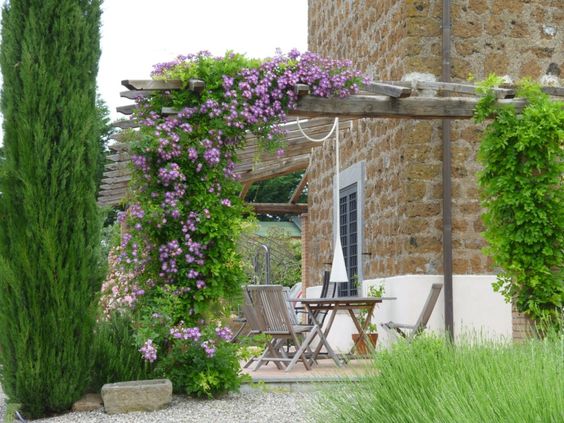
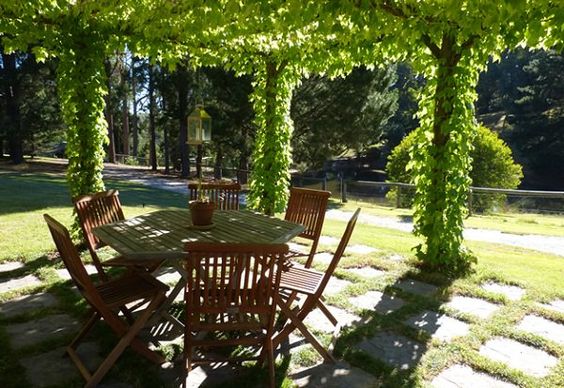
Pergolas are a great way to create an inviting outdoor space. They provide shade and a structure for climbing plants.
Using a pergola with climbing vines can add beauty and privacy to your garden. Plants like wisteria or clematis are perfect for this.
The dense foliage of climbing plants can also help cool down the area below, making it more comfortable. Research has shown that these plants can lower the surrounding temperature.
Incorporating a pergola near a seating area can make your outdoor space feel like an extension of your home. Adding outdoor furniture under the pergola provides a perfect spot for relaxation.
Choosing a pergola with natural materials can enhance the overall aesthetic of your garden. Wood pergolas, in particular, blend well with many garden styles.
Besides aesthetics, pergolas with climbing vines offer functional benefits. They can create shade on hot days and a cozy ambiance during cooler nights.
For those interested in ecological benefits, climbing vines around pergolas can also support local wildlife. Birds and insects often utilize these plants for shelter.
If space is an issue, a smaller pergola can still provide these benefits. Even a compact design can support various climbing plants and enhance your outdoor living space.
5) Rustic Outdoor Kitchen
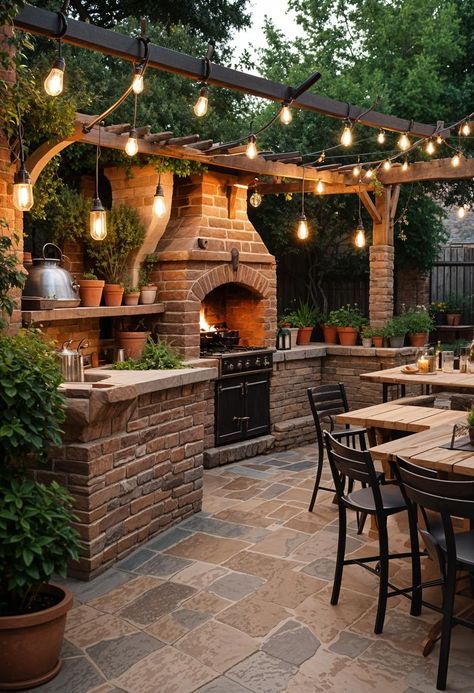
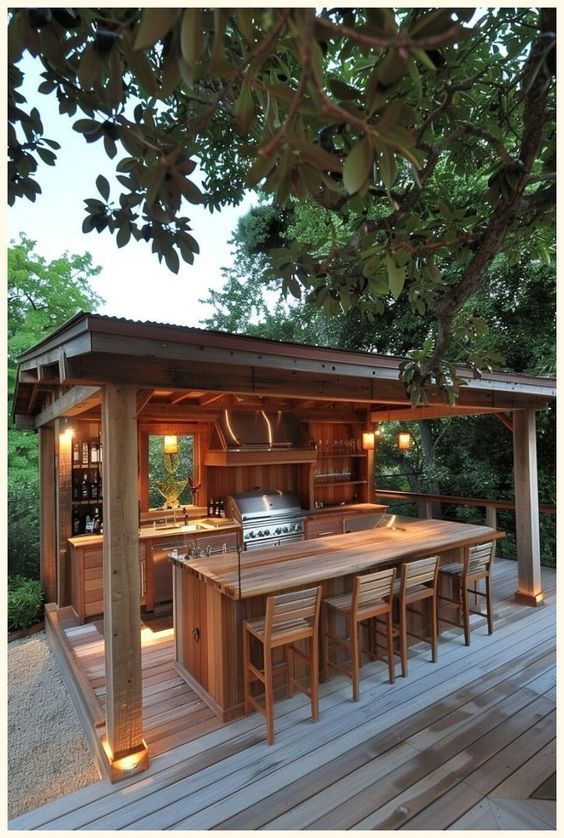
A rustic outdoor kitchen combines natural materials and a cozy atmosphere to create a perfect space for cooking and gathering outside. Think about using materials like wood, stone, and metal to bring a warm, earthy feel to the area.
Sheltered spaces are key. A covered porch can provide the needed protection from the elements while still allowing fresh air to flow. This can enhance the outdoor cooking experience, even in less favorable weather.
Consider building a stone patio to define the cooking space. This sets it apart from the rest of the yard and adds durability. Stone pathways leading to the kitchen also add charm and functionality.
Incorporating peeled logs into the design adds to the rustic charm. These can be used for support beams, furniture, or decorative touches. They blend seamlessly with nature, creating a harmonious look.
Think about your cooking needs. A basic setup like a grill and a few prep tables might be enough. For more ambitious cooks, a full kitchen setup with a sink, refrigerator, and storage can be both practical and inviting.
Personal touches matter. Add string lights for evening ambiance, comfortable seating for guests, and maybe even a rustic dining table made from reclaimed wood. Combine these elements to make the rustic outdoor kitchen a welcoming and functional space.
6) Hammock Haven
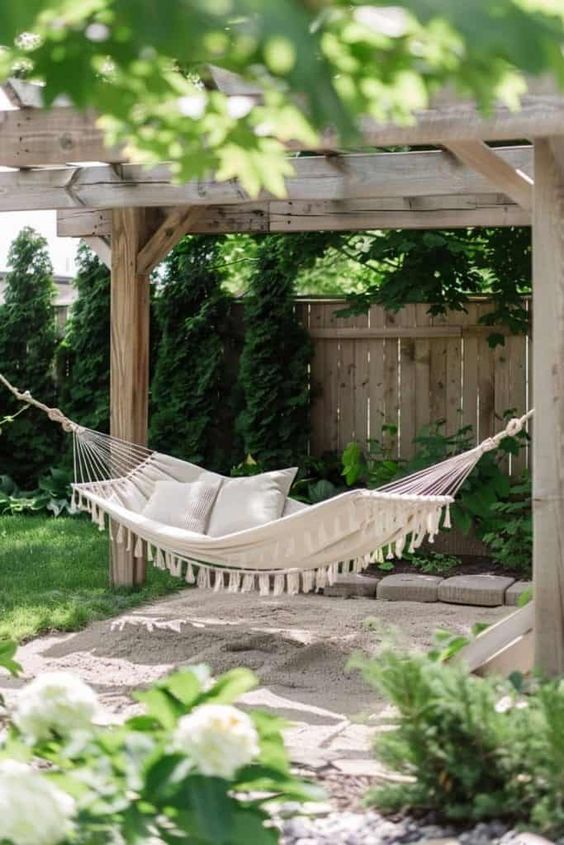

Creating a Hammock Haven is a great way to add a relaxing outdoor space to any backyard. The key is to find a shady spot, preferably under a tree, where you can install a hammock. This setup offers a peaceful retreat for reading, napping, or simply enjoying the fresh air.
Choosing the right hammock is important. There are many types available, from traditional rope hammocks to fabric and even portable options. Some hammocks are designed for one person, while others can accommodate two.
For extra comfort, add some outdoor pillows and a small side table for your drink or book. Surround the space with plants or flowers to enhance the tranquil atmosphere.
Lighting can also make a big difference. Consider using solar-powered lanterns or string lights to create a cozy ambiance in the evening. This makes the Hammock Haven a perfect spot to relax, both day and night.
A hammock can be a versatile addition to any outdoor space, providing a casual and comfortable place to unwind. It’s an easy way to enhance your garden or yard, making it more inviting and enjoyable. For more ideas on outdoor living spaces, check out this book on creating small-scale community.
Incorporate personal touches like a favorite throw blanket or seasonal decorations to make the Hammock Haven truly your own.
7) Water Feature Oasis
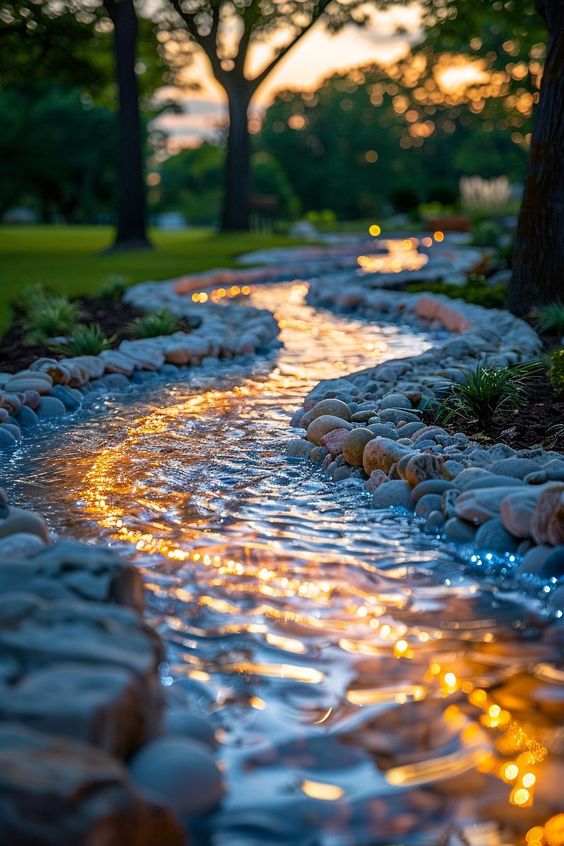
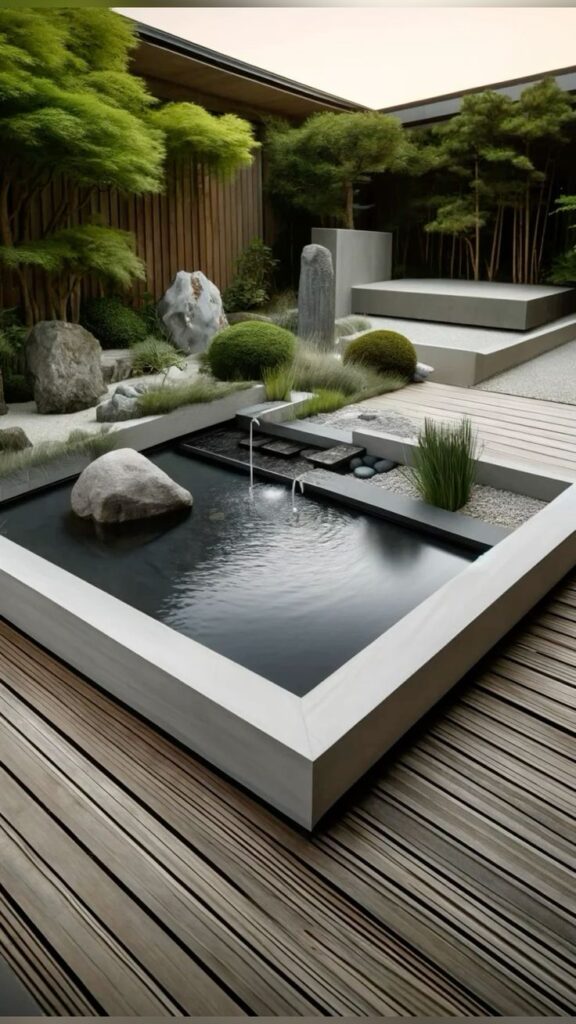
Adding a water feature can transform any outdoor living space into a peaceful retreat. The sound of running water can create a calming atmosphere and mask unwanted background noise.
Consider installing a small pond or fountain. A pond can become a focal point, drawing visitors’ eyes and providing a habitat for small wildlife.
Incorporating a solar pond aerator into your garden’s water feature is a fantastic way to enhance both beauty and sustainability. These aerators harness solar energy, helping to keep the pond water clean while reducing your energy consumption. Installing one not only improves water quality but also supports a healthier environment for fish and plants.
Fountains are versatile and can fit into smaller spaces. They come in various styles, from classical to modern, adding both visual and auditory appeal to the area.
For a larger garden, a waterfall can make an impressive statement. The flowing water over rocks mimics natural streams, creating a relaxing environment.
Pools can also serve as a water feature. Adding a waterfall or a series of fountains to a pool area enhances its aesthetic value.
Incorporating water features with greenery creates a balanced and natural look. Plants like water lilies or ferns around a pond add to the serene atmosphere.
Lighting can highlight the water feature at night. Underwater lights or spotlights can bring a magical quality to the space, making it enjoyable during evening hours.
For more on creating outdoor spaces with water features, you can explore this Outdoor Living Idea Book.
8) Convertible Bench Table
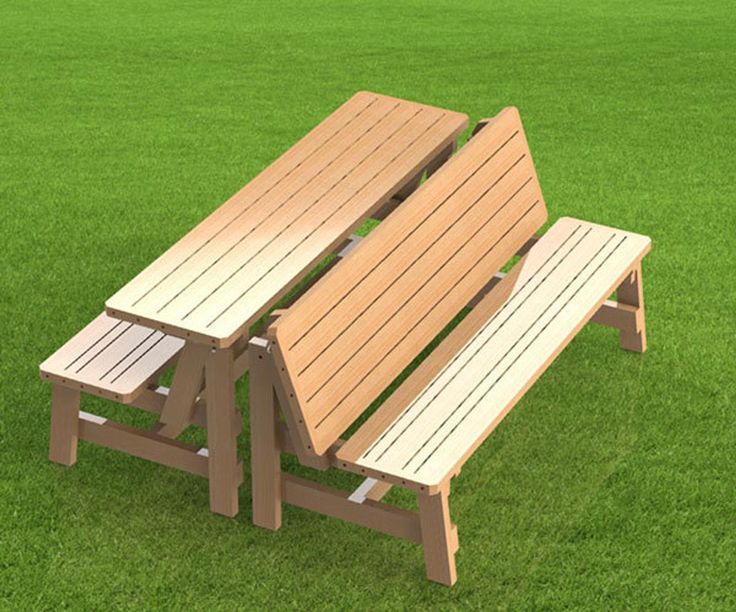
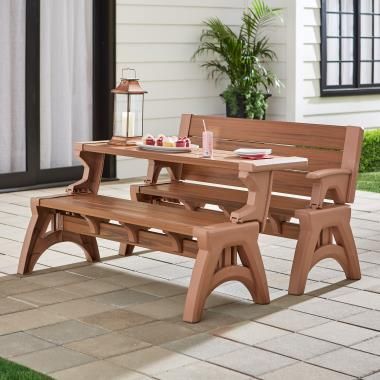
A convertible bench table is a versatile piece of outdoor furniture. It can transform from a bench to a table in just a few simple steps. This makes it perfect for small outdoor spaces where multifunctional furniture is essential.
When in the bench form, it can seat two to three people comfortably. It’s ideal for sitting and enjoying your garden or patio.
When converted into a table, it provides a perfect surface for outdoor dining or activities. This dual functionality helps maximize the use of your outdoor space.
Materials can range from wood and metal to plastic. Each offers different benefits and maintenance requirements. Wood offers a classic look, while metal and plastic can be more durable and weather-resistant.
Many options are available that emphasize ease of conversion. Look for models with simple mechanisms to switch between settings. This ensures that anyone can easily make the transformation without hassle.
To add comfort, consider adding cushions or padding. These can make both the bench and table modes more enjoyable. Select weather-resistant fabrics to ensure longevity and ease of cleaning.
A convertible bench table is not only practical but also stylish. It can complement various outdoor design themes and provide an elegant touch to your space.
This multifunctional furniture can truly enhance your outdoor living area. It’s a smart investment for anyone looking to make the most of their patio or garden.
9) String Light Canopy
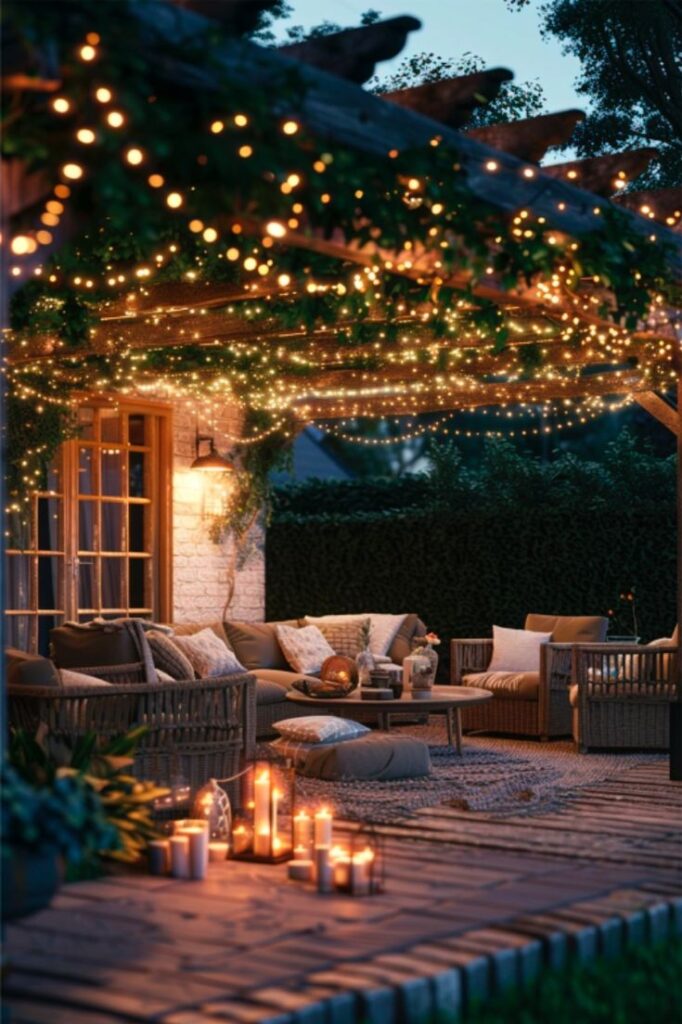
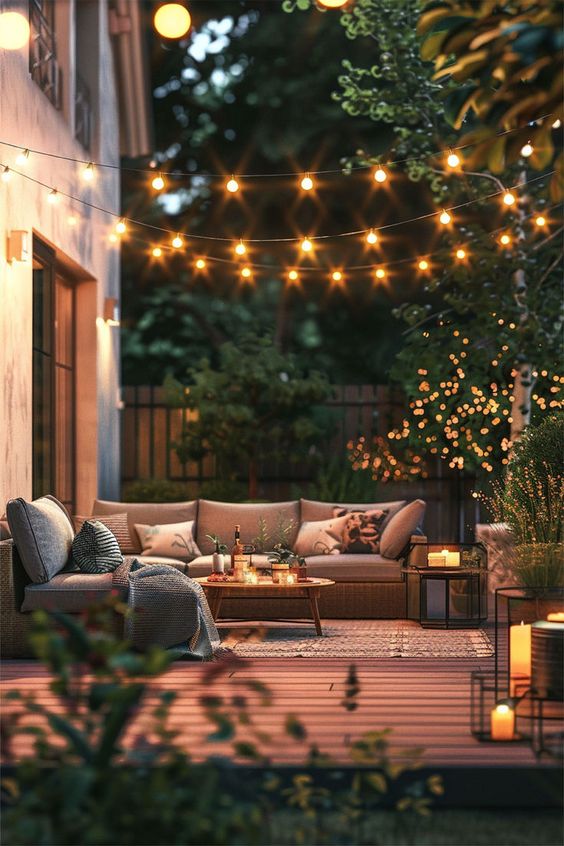
A string light canopy adds a magical touch to any outdoor living space. It can transform a backyard into a warm, inviting area perfect for evening gatherings. Hanging string lights from poles or trees creates a glowing roof of soft illumination.
These lights are versatile and can be used in various patterns. Some people crisscross them for a dense canopy, while others prefer a more spaced-out arrangement. Both styles can look stunning and provide ample light.
The type of light bulbs used also matters. While classic white bulbs are popular, colored bulbs can offer a fun, festive atmosphere. LED options are energy-efficient and long-lasting.
Installing a string light canopy is straightforward. Secure the lights between poles, trees, or any sturdy structures. It’s important to ensure they are hung securely to withstand wind and weather.
A string light canopy can be a standalone feature or part of a larger outdoor decorating scheme. It works well over dining areas, patios, or even small courtyards. By carefully planning the layout and installation, anyone can create a charming outdoor space that is both functional and beautiful.
For more ideas on creating an outdoor living area, consider the book “Light design and atmosphere” which discusses different lighting arrangements including string light canopies.
10) Zen Meditation Space
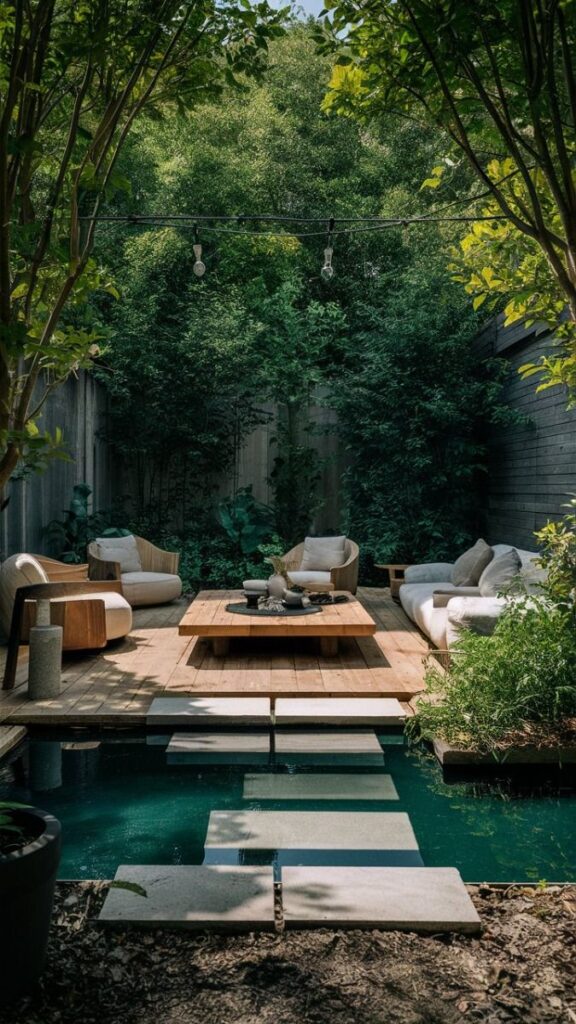
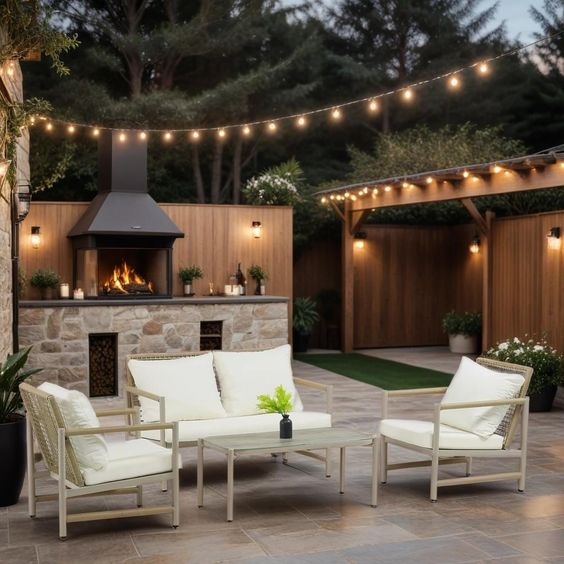
Creating a Zen meditation space in your outdoor area can offer a peaceful escape from daily stress. Focus on simplicity and natural elements to foster tranquility.
Use materials like bamboo, wood, and stone to create paths and sitting areas. A roofed outdoor living space can provide shade and protection, making the zone usable year-round.
Plants play a vital role. Opt for greenery that requires minimal maintenance and evokes calm, like moss, ferns, and small trees. Japanese maples and bonsai plants are also great choices for adding character and color.
Water features can significantly enhance the meditative atmosphere. Consider incorporating a small pond, fountain, or even a simple bird bath. The gentle sound of flowing water can help in creating a more serene environment.
Seating should be comfortable but not extravagant. Cushions or low benches are ideal. Being close to the ground helps with grounding and brings you closer to nature.
Add personal touches such as wind chimes, lanterns, or stone sculptures. These items can contribute to the overall ambiance and make the space uniquely yours.
Lastly, ensure the area is quiet and private. Bamboo screens or hedges can provide natural barriers to cut off outside noise and distractions. This helps create a more immersive meditation experience.
11) Outdoor Reading Nook
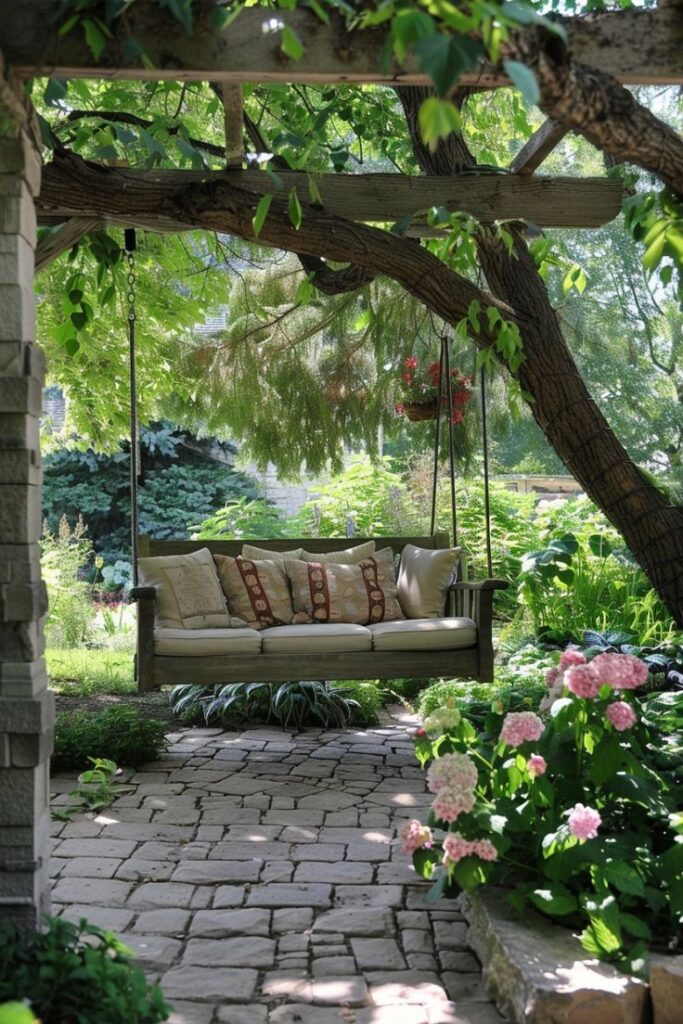
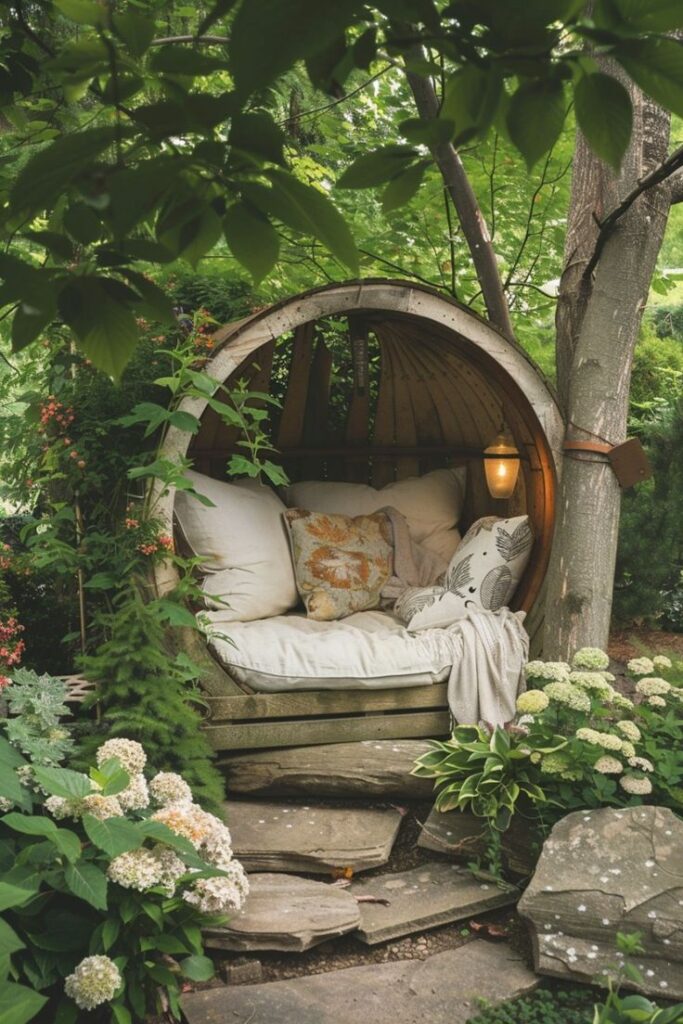
Creating an outdoor reading nook offers a cozy escape. Place a comfortable chair or hammock in a quiet spot. Add soft cushions and a blanket for chilly days. A small table nearby can hold books, drinks, and snacks.
Shade is important for a reading nook. Use a large umbrella, pergola, or plants to provide relief from the sun. String lights or lanterns can brighten the area for evening reading.
Plants around the nook can enhance the ambiance. Choose fragrant flowers or lush greenery to create a peaceful environment. Wind chimes or a small water fountain can add soothing sounds.
Insect repellent is also useful. Mosquitoes can ruin reading time. Use citronella candles or an electric bug zapper to keep them away.
Adding personal touches can make the nook feel special. A favorite throw pillow, pictures, or decorations can make it uniquely yours. A bookshelf or storage box can keep your reading materials organized.
With these simple steps, an outdoor reading nook becomes a perfect retreat.
12) Garden Swing Seat

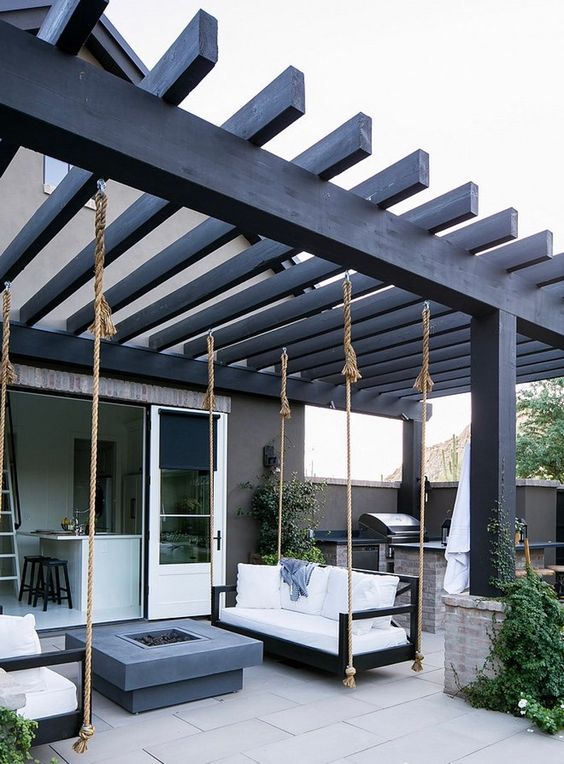
A garden swing seat can transform any outdoor space into a peaceful retreat. It’s perfect for relaxing, reading, or simply enjoying the garden. These seats come in various styles like a tire, a knot on a rope, or a traditional wooden board, making them versatile for any garden design.
Adding a swing seat encourages outdoor activity and can be a charming focal point. It’s ideal for both children and adults, providing a fun spot to unwind. For those with smaller spaces, a vertical design like a hanging chair can be a space-efficient solution.
Placement is key. Situate the swing seat in a spot with a good view of the garden or a shaded area for cool comfort. Ensure the swing has sturdy support, whether it’s a strong tree branch or a specially designed frame.
This feature enhances not only the aesthetic appeal but also the functionality of the garden. It combines comfort with style, inviting everyone to spend more time outdoors. It’s a simple addition that can bring joy and relaxation to any garden space.
For families with children or those planning to host gatherings, selecting durable playground equipment and playground turf adds an extra layer of functionality and enjoyment. This type of play structure not only provides endless entertainment but also ensures longevity and safety for kids. When investing in outdoor furniture, consider adding durable playground equipment to create a well-rounded, family-friendly environment that encourages outdoor activities for all ages.
For more detailed ideas on outdoor living spaces, check Landscapes for Learning.
Planning Your Outdoor Living Space
Planning an outdoor living space involves evaluating your available area and setting a realistic budget. This will help you design a functional and attractive space.
Assessing Your Space
First, measure the area where you plan to set up your outdoor living space. Take note of existing features like trees, pathways, and structures. Create a rough sketch to visualize the layout.
Consider the potential uses of the space. Think about seating areas, fire pits, dining spaces, and gardens. Prioritize the features you value the most.
Lighting: Add fixtures for evening use.
Privacy: Think about fences, walls, or plants.
Climate: Choose materials that withstand local weather.
Setting a Budget
Estimate costs for major elements such as furniture, lighting, landscaping, and decorative items. Make a list:
- Furniture: Tables, chairs, loungers
- Lighting: String lights, lanterns
- Landscaping: Plants, mulch
- Miscellaneous: Fire pits, grills
It is wise to leave a buffer for unexpected expenses. Look for sales and discounts, or consider DIY projects to save money. Prioritize essentials before adding luxury items.
Design Elements for Outdoor Living Areas

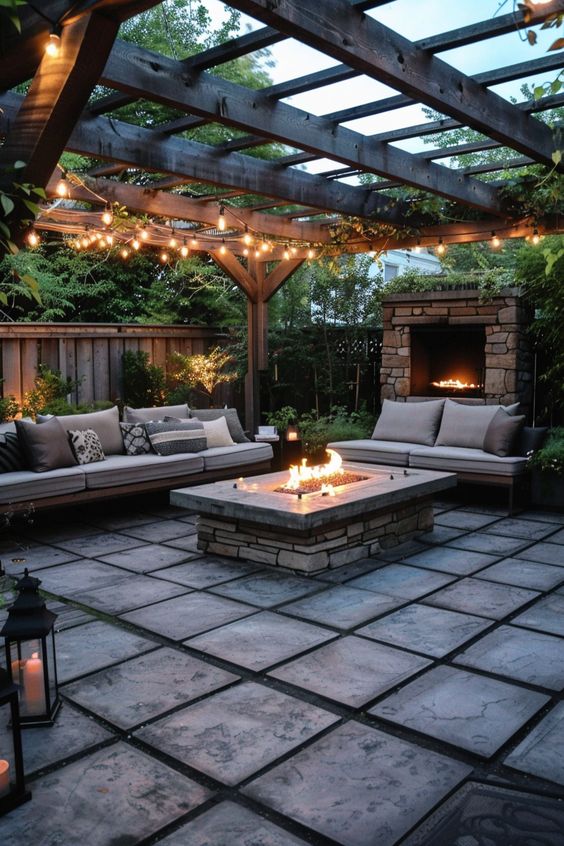
Creating an inviting and functional outdoor living area involves careful selection of furniture and thoughtfully designed lighting. These elements enhance comfort and usability.
Choosing the Right Furniture
The furniture chosen for outdoor spaces significantly impacts the overall ambiance and comfort. Durability is crucial; materials like teak, aluminum, and synthetic wicker are weather-resistant and long-lasting. Comfort should also be a priority, with options like cushioned seating and ergonomic designs. Versatility is another key aspect; modular furniture sets can be rearranged to suit different occasions or needs.
Considering the space’s function helps in selecting the right pieces. For dining areas, a sturdy table and comfortable chairs are a must. For relaxation zones, lounge chairs or hammocks are ideal. Storage solutions, like benches with hidden compartments, keep the area tidy and organized.
Incorporating Lighting Features
Lighting plays a vital role in making outdoor spaces usable after dark and in enhancing the atmosphere. String lights create a cozy and festive look, perfect for evening gatherings. Pathway lights ensure safety by illuminating walkways and garden paths. Wall-mounted lights or sconces add functional and aesthetic value to patios or decks.
Solar-powered options are eco-friendly and cost-effective, reducing the need for electrical work. LED lights are also a great choice for their energy efficiency and long lifespan. Dimmer switches offer flexibility, allowing the light intensity to be adjusted to suit different moods or activities. Properly placed lighting can highlight architectural features and landscaping, adding depth and interest to the space.
By focusing on these elements, outdoor areas can become extensions of indoor living spaces, providing comfort, functionality, and aesthetic appeal.
Maintenance Tips for Outdoor Living Spaces
Proper maintenance of outdoor living spaces involves both protection from weather and regular cleaning. This ensures your space remains inviting and lasts longer.
Protecting Against Weather
To shield outdoor areas from the elements, consider using covers for furniture when not in use. Waterproof covers prevent rain damage and extend the life of the furniture. Applying a UV-resistant finish to wooden pieces can protect against sun damage, reducing fading and cracking.
In areas with harsh winters, consider storing your outdoor furniture indoors or in a shed during the off-season. This prevents snow and ice from causing damage. Ensure that cushions are made of weather-resistant fabric and are stored away from moisture to avoid mold and mildew.
Regular maintenance of metal furniture is also important. Using a protective sealant can prevent rust, while occasional cleaning with soapy water will keep it looking new. For patios and decks, applying a water sealant to wood or a protective coating to concrete can reduce weather-related wear and tear.
Cleaning and Care
Consistent cleaning helps maintain the appearance and functionality of your outdoor living space. For wooden furniture, use a mild detergent solution and a soft brush to remove dirt and grime. Avoid harsh chemicals as they can damage the finish. Rinse thoroughly with water and allow to dry completely.
Metal furniture can be cleaned with a mixture of water and mild soap. For tougher stains or rust, a paste made of baking soda and water can be effective. After cleaning, drying the furniture completely helps prevent rust.
For cushions and upholstery, regular vacuuming and spot cleaning are essential. Use a fabric-safe cleaner for stains and always follow the manufacturer’s instructions. It’s important to let cushions air dry completely before putting them back to avoid mold.
Maintaining the cleanliness of patios and decks is also crucial. Sweeping regularly to remove debris and occasionally washing with a power washer can keep surfaces clean. For stone or brick areas, using a gentle cleaner designed for the material will prevent damage.
- 8.9Kshares
- Facebook0
- Pinterest8.9K
- Twitter0
